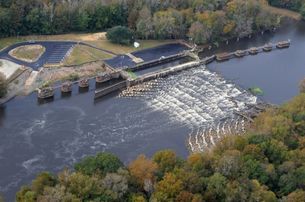|
5/19/2017 A River-Friendly and Fiscally Responsible Future for the New Savannah Bluff Lock & DamRead NowThe dam at New Savannah Bluff is in need of major repairs, for which there is currently no source of funding. The Savannah Harbor Expansion Project (SHEP) mitigation agreements require the construction of a passage for migratory fish species. In spring 2016, Savannah Riverkeeper and other stakeholders presented the idea to combine the two projects to federal lawmakers reworking the WRDA bill. The new WRDA language allows the Corps of Engineers to explore using Savannah Harbor Expansion Project mitigation funds designated only for the fish passage to address structural deficiencies in the aging Lock & Dam. They must now complete both an implementation strategy and an environmental analysis of all options to study their effects. What Does the WRDA Bill Mean for Lock & Dam? Congress has approved changes to language in the Water Resources & Development Act (WRDA), which funds and authorizes water resource projects throughout the U.S. The updated act does the following for the New Savannah Bluff Lock & Dam: 1. mandates repair of the lock wall; 2. obligates the Corps of Engineers to maintain current pool for navigation, water supply, and recreation; 3. requires construction of a fish passage for endangered and migratory species; 4. transfers ownership of the park and recreation area adjacent to the New Savannah Bluff Lock and Dam from the Corps of Engineers to Augusta-Richmond County, with no cost incurred by the city. What Does Savannah Riverkeeper Support? Savannah Riverkeeper advocates for the construction of a rock weir in place of the current dam, which would: 1. meet the criteria for a fish passage; 2. maintain the functions of pool and flood control the Lock & Dam has provided for upstream users; 3. save millions in local funds by combining two projects; and 4. open the area to opportunities for river-based recreation and economic growth. Will Augusta's River Region Risk Increased Flooding? The Corps of Engineers are, for the first time, under legal requirement to maintain pool levels and will continue to do so in times of flood risk. It is of utmost importance to understand that the Lock & Dam provides no flood control above 30,000 cubic feet per second, which is the level at which Downtown and North Augusta begin flooding. Due to a system called No-Rise Certification for Floodways, in place by FEMA, there can be no increased risk of flooding to the area as a result of this or any approved project. Additionally, extensive planning and numerous studies must be completed before such a project could move forward. How Can I Learn More? There are many facets to take into consideration on this complicated issue, and Savannah Riverkeeper will attempt to address them point-by-point and keep the public informed as the process unfolds. We believe that this project holds an exciting opportunity for Augusta's River Region. To contribute a question, please email [email protected] with the subject: Lock & Dam. Look for us in local news coverage and stay tuned for more answers as we hear from you. For more insight or to share with your school, club, or friends, download the info sheet below. You can also read a copy of our official comment submitted to the Corps of Engineers.
How Can I Take Action?
Studies are underway to determine a solution for the future of the New Savannah Bluff Lock & Dam, and the U.S. Army Corps of Engineers requests input from local city officials, industry and the public in general before determining how best to meet the intent of the law and address the concerns of the local community. Comments will be accepted until June 3, 2017. Send comments by email to [email protected] or in writing by mail to: Savannah District, U.S. Army Corps of Engineers Planning Division: ATTN Mr. Nathan Dayan 100 West Oglethorpe Avenue Savannah, GA 31401-3640 You can also sign the petition to tell the Corps of Engineers you support a river-friendly and fiscally responsible future for the Lock & Dam.
0 Comments
Leave a Reply. |
|||||||||||||
Savannah Riverkeeper, Inc. • Augusta, GA • Allendale, SC • Savannah, GA
P.O. Box 60 Augusta, GA 30903 USA • [email protected]
Toll Free 844-263-1415 • Office 706-826-8991 • Fax 706-826-8995
Savannah or Allendale: 912-454-8048
EIN # 58-2630660
P.O. Box 60 Augusta, GA 30903 USA • [email protected]
Toll Free 844-263-1415 • Office 706-826-8991 • Fax 706-826-8995
Savannah or Allendale: 912-454-8048
EIN # 58-2630660

